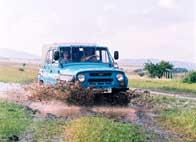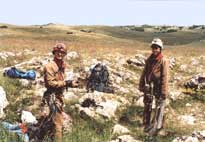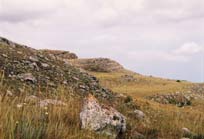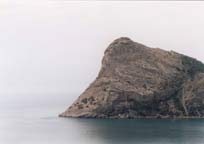Bat census |
||
The project was supported by BP Conservation Programme (award of 2004 year).
The Crimea is one of the richest regions of Ukraine
on number of bats' species. Totally, 20* species had been registered
here (from 26 bat species of Ukraine's fauna). 14 from them have
been marked for underground cavities. 7 species have a protection
category according IUCN Red list. All bat species of the region
are included into the lists, protected by one international agreements
and two conventions. 9 species are included into the Red book of
Ukraine (×åðâîíà êíèãà Óêðà¿íè..., 1994). At the territory of Crimean
peninsula there are more than 1000 known karst caves (98 percent
of which are concentrated in Crimean Mountains) and not karst natural
cavities. Beside it the territory is rich in exhausted underground
limestone quarries. Beside general species richness, the Crimean
region was known for the biggest bats' aggregations for all territory
of Ukraine. In past three species (Rhinolophus ferrumequinum,
Myotis blythii, Miniopterus schreibersii) formed great colonies
in caves of the Crimea. _________________ * Few years ago a presence of two more species in
the region was suggested — R. mehelyi and R. euryale. However, during
the work, no reliable evidences on their records in the Crimea were
found, that is why we don’t consider them.
L. Godlevska (leader), M. Ghazali, Ya. Petrushenko (Schmalhausen Institute of zoology of NAS of Ukraine), V. Mysjuk (Lviv national University), T. Postawa (Institute of systemtics and evolution of animals OF PAS), Z. Nagy (Transylvanian museum association).
During the summer of 2004 (June – beginning of August) and winter of 2005 (February – beginning of April) 57 underground sites of the region were checked. They included natural karst caves, coastal grottos and systems of exhausted limestone quarries of the mountain, coastal and plain Crimea. The work was carried out on a typical scheme. In summer caves were examined in the daytime, netting (with mist-nets and a harp-trap) was realized in the night-time at entrances to caves.
Bats were found for 34 from 57 underground shelters. Totally in checked caves 14 species have been registered: all known before troglophile species, excepting M. schreibersii, which remains to be in the list of vanished animals of the region. Two species, Pipistrellus pygmaeus, Nyctalus leisleri were recorded outside of cavities. Among species found there are such rare for Ukraine ones as Myotis nattereri, Myotis emarginatus, Barbastella barbastellus, Hypsugo savii, N. leisleri. Three of them (M. emarginatus, N. leisleri, H. savii) were found here for the first time after a long time interval. Big aggregations (> 100 ind.) were found only for 3 species (R. ferrumequinum, M. blythii, M. emarginatus). These three species were revealed to form maternity colonies in checked caves; although single pregnant females were netted at entrances to caves for three more species (Rhinolophus hipposideros, Plecotus auritus and P. austriacus). In summer the biggest bats' aggregation encountered in one underground object included about 9000 specimens of three species; in winter, about 1500 individuals of four species. The most tragic changes in the Crimean bat fauna concerns with disappearance of M. schreibersii. Since 1947 it hadn't been registered in the region at all. Beside it all known in the past aggregations of M. blythii decreased in 10-100 times or disappeared at all. Certain data testifie about a decreasing of colonies of R. ferrumequinum. Based on recent results we marked out 9 important
bat sites: six ones, at the territory of the Plain Crimea and three
of them in the Coastal-Mountain Crimea. Urgent protection measures
must be implemented for preservation of key underground sites determined.
Photo by L. Godlevska, T. Postawa, V. Mysjuk
|
||
14.06.2006. |
||
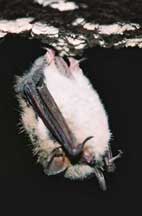 Support
Support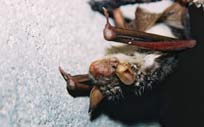 By
the last quarter of the 20th century a decreasing in number of known
bats' aggregations had been marked and full disappearance of one
of three species of the region — M. schreibersii had been
recorded. For last decades investigations of bats of the region
had had a rather fragmentary character. Thus, our aim was to carry
out a full-scale census to determine a current state of cave dwelling
bats in the Crimea. An important task of our investigations was
to mark out important bat sites for their further protection. An
additional aim of the work was to rise attention of local public
and reservers to the necessity of bats' and bat roosts' protection
of the region.
By
the last quarter of the 20th century a decreasing in number of known
bats' aggregations had been marked and full disappearance of one
of three species of the region — M. schreibersii had been
recorded. For last decades investigations of bats of the region
had had a rather fragmentary character. Thus, our aim was to carry
out a full-scale census to determine a current state of cave dwelling
bats in the Crimea. An important task of our investigations was
to mark out important bat sites for their further protection. An
additional aim of the work was to rise attention of local public
and reservers to the necessity of bats' and bat roosts' protection
of the region.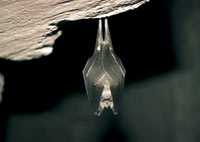 Main field-work results
Main field-work results 

